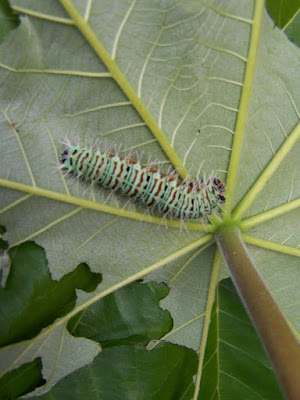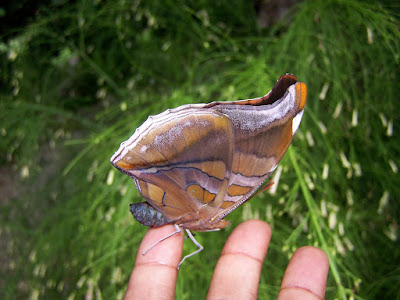Good news! I was using the new editor in blogger and that wasn't working, so I went back to the old editor and am back in action. As they say new brooms sweep clean...but old ones know the corners.
 The Orion butterfly caterpillar (historis odius)
The Orion butterfly caterpillar (historis odius)A few weeks ago my husband spotted an Orion butterfly near the house and mentioned it to me. I replied that they must be laying their eggs on the Cercropia trees I had planted for that purpose hoping one day that would happen. So I quickly ran into the garden and looked up in the tree. Ha there were these little caterpillars munching away on the leaves. We had never seen the caterpillars before, so to make sure these were the Orion caterpillars, we clipped a leaf and placed it in a container for observation.

 Like most butterfly caterpillars they tend to take on the colouring of their immediate surroundings for protection against predators.
Like most butterfly caterpillars they tend to take on the colouring of their immediate surroundings for protection against predators.
 I was rather surprised when this caterpillar turned a bright yellow, hubby thought that something was wrong.
I was rather surprised when this caterpillar turned a bright yellow, hubby thought that something was wrong. It was getting ready to go into the chrysalis stage.
It was getting ready to go into the chrysalis stage.This is when it goes into the J shape and hangs. It will remain like this for 24 hrs.
 The chrysalis hung there for 8 days and on the 9th day it darkened. This is usually a sign that the butterfly will soon be born. You can actually see the wings through the casing.
The chrysalis hung there for 8 days and on the 9th day it darkened. This is usually a sign that the butterfly will soon be born. You can actually see the wings through the casing.
I found this one in my garden under the cordyline leaf.
 Orion butterflies feed on rotted fruit, they are also nicknamed stinky wings. To attract them we placed old bananas , plantain, carambola and guava outside on a table.
Orion butterflies feed on rotted fruit, they are also nicknamed stinky wings. To attract them we placed old bananas , plantain, carambola and guava outside on a table. As if by magic one soon appeared. I was elated. Notice the proboscis taking up all the sweet juices from the fruit.
As if by magic one soon appeared. I was elated. Notice the proboscis taking up all the sweet juices from the fruit. I thought I had seen two butterflies in the area but wasn't sure if it were the same one. So I told my husband that there might be two butterflies. He said that he wasn't believing anything until he had seen it himself and that he had read somewhere that these butterflies were not sociable creatures. He probably though that I was hallucinating but I knew deep down that there were two I had seen.
I thought I had seen two butterflies in the area but wasn't sure if it were the same one. So I told my husband that there might be two butterflies. He said that he wasn't believing anything until he had seen it himself and that he had read somewhere that these butterflies were not sociable creatures. He probably though that I was hallucinating but I knew deep down that there were two I had seen. A while later I heard a shout from my doubting hubby to come quickly! I ran with my camera in hand and ha ha ha....there were two butterflies feeding. I wasn't seeing doubles after all!
A while later I heard a shout from my doubting hubby to come quickly! I ran with my camera in hand and ha ha ha....there were two butterflies feeding. I wasn't seeing doubles after all!
 Cercropia peltata the larval food for the Orion (historis odius) These are beautiful trees found growing in gullies and hillsides.
Cercropia peltata the larval food for the Orion (historis odius) These are beautiful trees found growing in gullies and hillsides.

 It is very difficult to get a shot of the Orion with their wings open. This is one of the few I have managed to take so far .
It is very difficult to get a shot of the Orion with their wings open. This is one of the few I have managed to take so far .
in my hands
I've go the O----RION
in my hands
I've got the whole world
in my hands
I've got the O-----RION
in my hands
The Orion ranges from Cuba to the Greater and Lesser Antilles, Mexico to Argentina. Its wing span is 110 - 130 mm or 4½ to 5½ inches. Larval food is Cercropia peltata trees, also known as Bois canoe in creole. The Orion is a large butterfly with velvety dark brown and orange on the upper wings and dark brown with white bars on the underneath. When closed the wings resemble a dry leaf or a piece of bark, which allows the Orion to blend in with its surroundings without being seen. It feeds on rotting fruit and is a high flier.
I've got the whole world
in my hands
I've got the O-----RION
in my hands
The Orion ranges from Cuba to the Greater and Lesser Antilles, Mexico to Argentina. Its wing span is 110 - 130 mm or 4½ to 5½ inches. Larval food is Cercropia peltata trees, also known as Bois canoe in creole. The Orion is a large butterfly with velvety dark brown and orange on the upper wings and dark brown with white bars on the underneath. When closed the wings resemble a dry leaf or a piece of bark, which allows the Orion to blend in with its surroundings without being seen. It feeds on rotting fruit and is a high flier.



































